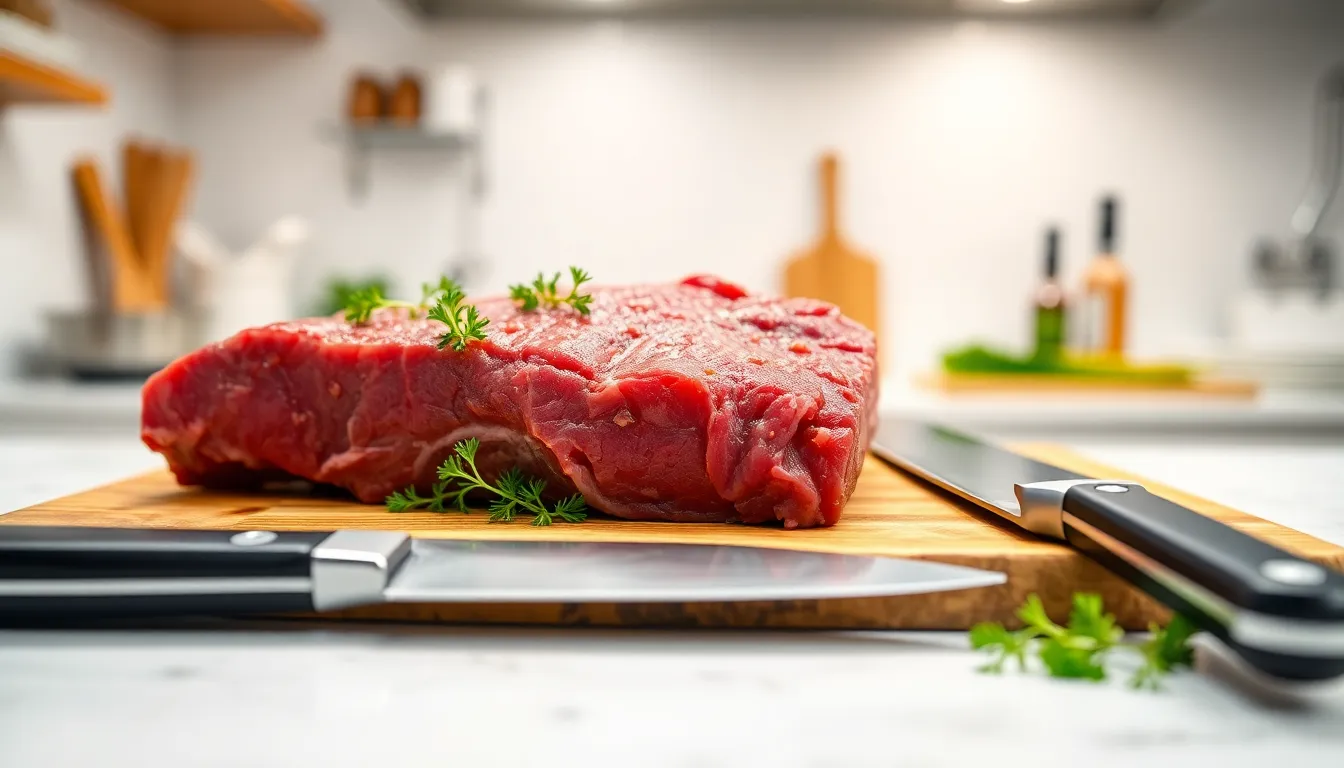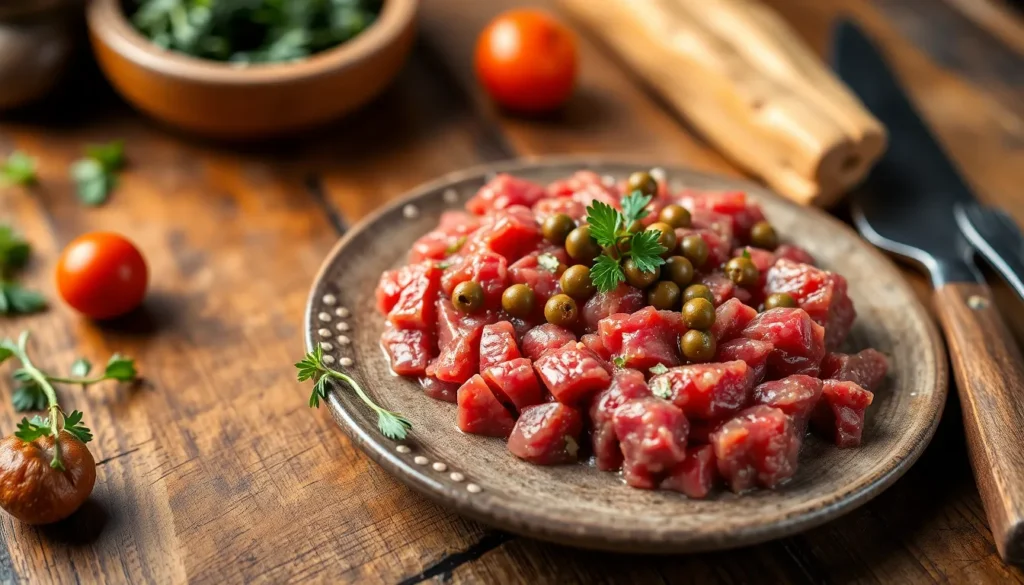When it comes to culinary adventures, few topics spark as much debate as eating raw beef. Some might think it’s a daring delicacy while others shudder at the thought. Imagine sitting at a trendy restaurant, savoring a plate of tartare, while your friends eye you like you’ve just joined a secret society of meat rebels. But is it safe?
Table of Contents
ToggleCan You Eat Beef Raw?
Consuming raw beef poses both culinary delights and health risks. Raw beef dishes, such as steak tartare and carpaccio, are considered delicacies in various cuisines. They often attract adventurous eaters seeking unique gastronomic experiences.
Health experts warn against eating raw beef due to the risk of foodborne illnesses caused by bacteria like E. coli and Salmonella. Contamination can occur during the processing and handling of meat. Risks increase when the meat is sourced from less regulated suppliers or improperly stored.
Safe consumption is possible with high-quality, fresh cuts of beef. Opting for whole cuts rather than ground beef promotes better safety. Ground beef commonly has more exposure to bacteria since grinding spreads pathogens throughout the meat.
Choosing reputable sources also enhances safety. Purchasing from trusted butchers or certified suppliers reduces the risk of contamination. Inspections and quality standards play vital roles in ensuring safety for raw meat consumption.
Following safe handling practices is essential. Keeping raw beef refrigerated at temperatures below 40°F minimizes bacterial growth. Washing hands and surfaces after contact with raw meat can prevent cross-contamination.
Ultimately, passion for culinary exploration can come with cautious choices regarding raw beef. Understanding the associated risks and pursuing safe practices enables informed decisions. Recognizing personal tolerance for risk enhances enjoyment of such dishes.
Safety Concerns

Eating raw beef poses several safety risks that consumers must consider. Pathogens like E. coli and Salmonella often lurk in raw meat, leading to severe foodborne illnesses. Contaminated beef can enter the food supply during processing or handling. Those who consume ground beef face higher risks, as grinding spreads bacteria throughout the meat.
Cross-contamination during preparation can amplify these concerns. Cutting boards and utensils used for raw beef can transfer pathogens to other foods. Keeping separate cutting boards for raw and cooked items prevents this issue. It’s essential to wash hands, surfaces, and utensils after handling raw beef. Following these precautions minimizes the chance of illness while enjoying culinary treats like steak tartare.
Nutritional Aspects
Eating raw beef provides specific nutritional benefits, particularly in protein content and essential vitamins and minerals. While some might hesitate, understanding these aspects can inform dietary choices.
Protein Content
High protein levels characterize raw beef, offering about 25 grams of protein per 3-ounce serving depending on the cut. This makes it an excellent source for those seeking muscle maintenance and repair. Absorption of protein occurs efficiently in its raw form, which may appeal to fitness enthusiasts. Sourcing high-quality beef enhances protein benefits, as lower-quality options can diminish nutritional value. Choosing cuts like tenderloin can ensure optimal protein consumption, aligning with nutritional goals.
Vitamin and Mineral Benefits
Raw beef contains critical vitamins and minerals, including vitamins B6 and B12, iron, and zinc. Vitamin B12 plays a vital role in maintaining nerve function and producing red blood cells, while iron aids in oxygen transport within the body. A 3-ounce serving of raw beef offers approximately 2.5 milligrams of zinc, essential for the immune system. These nutrients contribute to overall health, making raw beef a potential component in balanced diets when handled safely. Opting for grass-fed beef might further enhance vitamin content, promoting nutrient-rich culinary experiences.
Culinary Uses
Raw beef features prominently in several culinary traditions. Many enjoy dishes like steak tartare, which combines finely chopped raw beef with ingredients such as capers and onions. Carpaccio also highlights raw beef, served in thin slices and often drizzled with olive oil and lemon.
Dishes Featuring Raw Beef
Classic raw beef dishes include steak tartare, carpaccio, and beef sashimi. Steak tartare traditionally uses high-quality cuts, often seasoned with spices and sauces. Carpaccio showcases thinly sliced beef, usually served as an appetizer. Beef sashimi, a component of Japanese cuisine, emphasizes freshness and quality, often paired with soy sauce and wasabi.
Popularity in Different Cultures
Raw beef enjoys varied popularity across cultures. In France, steak tartare is a staple in high-end restaurants, reflecting culinary sophistication. Italian cuisine proudly presents carpaccio as a refined starter, appreciated for its simplicity and fresh ingredients. Meanwhile, Japanese cuisine embraces beef sashimi, showcasing the importance of premium meat quality. Each culture approaches raw beef with unique flavors and preparations, highlighting its culinary versatility.
Preparation Methods
Preparation methods for consuming raw beef require careful consideration. Selecting quality beef is crucial for both safety and flavor.
Sourcing High-Quality Beef
Sourcing high-quality beef ensures a safer dining experience. Look for trusted suppliers or farms that prioritize health standards. Whole cuts of beef offer lower contamination risks compared to ground options. Freshness plays a significant role in taste and safety, as older meat harbors higher bacteria levels. Grass-fed beef often contains more vitamins and nutrients, adding health benefits. Certification labels, such as USDA Choice or Prime, can guide consumers toward better options. Ultimately, purchasing from reputable sources minimizes exposure to harmful pathogens.
Recommended Techniques
Recommended techniques for safely preparing raw beef include proper handling and storage practices. Cleaning surfaces and utensils before and after use is vital to prevent cross-contamination. Keeping beef refrigerated at temperatures below 40°F limits bacterial growth. When preparing dishes like steak tartare, use separate cutting boards for raw meat and other foods. It’s also important to utilize sharp knives for clean cuts, preserving the meat’s texture. When marinating or seasoning raw beef, do so just before serving to maintain freshness. Ensuring these safety measures creates a more enjoyable experience with raw beef dishes.
Exploring the world of raw beef can be an adventurous culinary experience. It offers unique flavors and nutritional benefits that appeal to many food enthusiasts. However, it’s essential to approach this delicacy with caution.
Understanding the risks associated with consuming raw beef is crucial. Selecting high-quality cuts from reputable sources and adhering to safe handling practices can significantly reduce the chances of foodborne illnesses.
By being informed and taking necessary precautions, individuals can enjoy dishes like steak tartare and carpaccio while minimizing health risks. This balance between culinary exploration and safety allows for a more enjoyable and confident dining experience.

